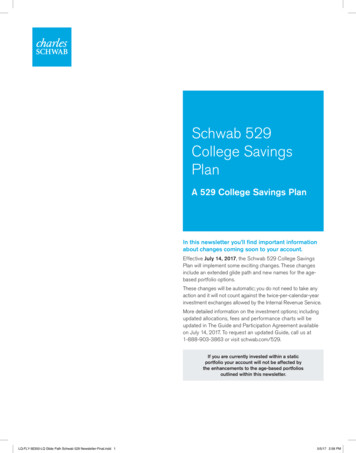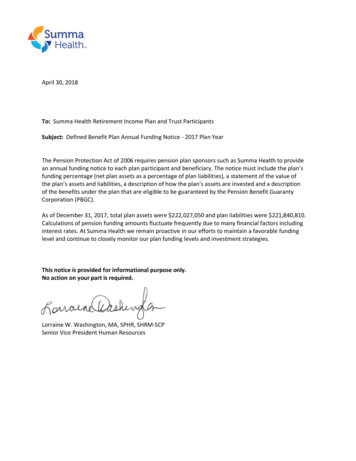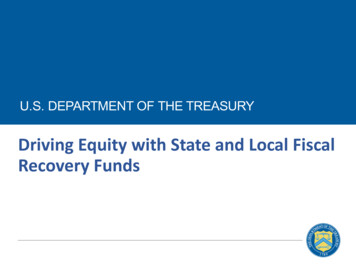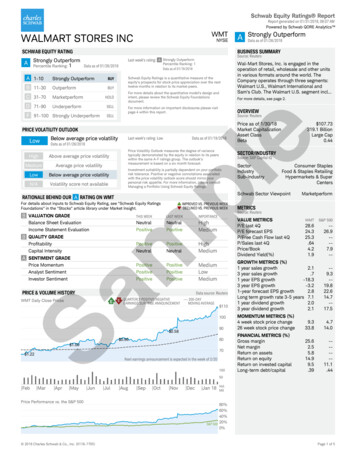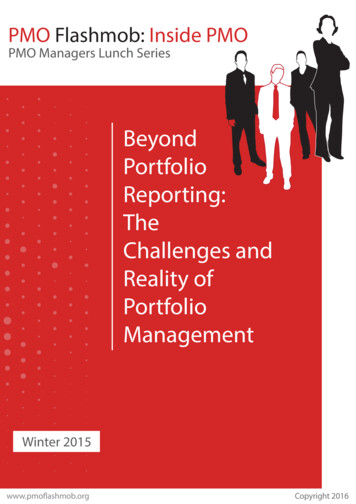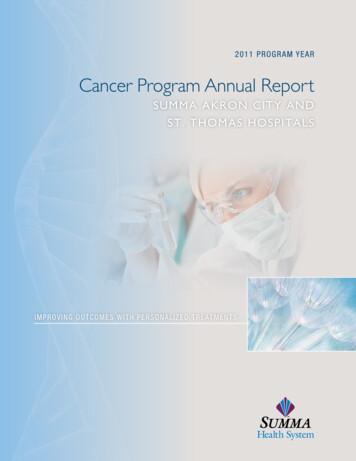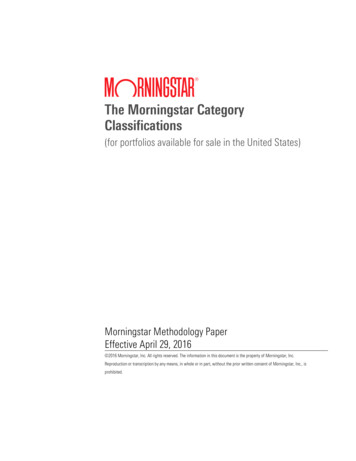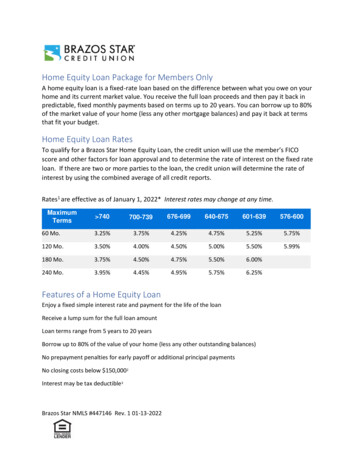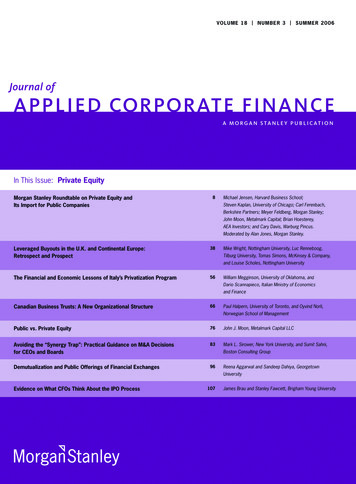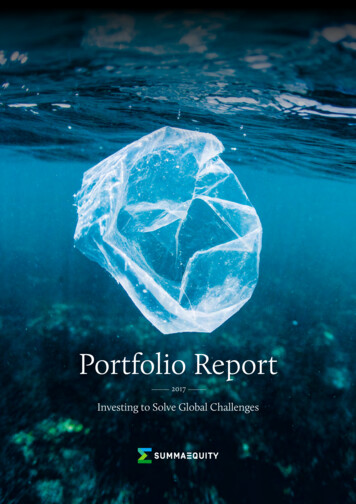
Transcription
Portfolio Report2017Investing to Solve Global Challenges
Contentsour approachportfolio overviewSumma Equity. 4Acqisition timeline andportfolio SDG alignment.17Letter from the Managing Partner.5Our Approach. 6Commitment to sustainabledevelopment.7our investmentsLin Education.18Egain. 20megatrendsSortera.22Megatrends and Investment Themes. 11Milarex. 24investment themesSumma’s Investment Themes. 12via summaVia Summa. 13esg integrationDeal sourcing.14ESG integration.14Determining materiality. 15sortera case studyValue creation throughESG improvement: Sortera.16Norsk Gjenvinning. 26EcoOnline. 28Pagero. 30Summa Digital.32metricsFinancials.34Social aspects. 35Environmental Aspects.36summatesMeet the Summates.37Summa Board.383
Summa EquityInvesting to solve global challengesINVESTMENT STRATEGYGEOGRAPHIC FOCUSSECTORThematicNordicsPrivate Equity2017 PORTFOLIO REVENUE2017 PORTFOLIO EBITDASEK 2 667m1SEK 293m2 56%NO. OF EMPLOYEES% FEMALECARBON FOOTPRINT1145%6 527 tonnesSDG ALIGNMENT2017 GROWTH (PORTFOLIO REVENUE)KPIs7acquisitionsresponding toSDG challenges34,7bnSEK raisedin fund IFUND PERFORMANCEThe portfolio has performed strongly to date,delivering in aggregate 56% revenue growth and86% EBITDA growth in 2017.4123adjusted for portfolio add-ons; excludes NG.adjusted for portfolio add-ons, excludes NG and Summa Digital.Relates to the number of platforms and does not include add-on acquisitions. NG is not included, as this transaction was finalised in 2018.1,9bnSEK deployedby year end2017
our approachLetter from the Managing PartnerHerbert Stein once said “If something cannot go on forever,it will stop” or in other words, it isn’t sustainable.The purpose of Summa Equity is to invest to solve some ofthe major challenges facing the world today. We believe thatthose companies that develop innovative solutions to thesechallenges are the ones that will outperform.We are proud of the portfolio of companies that we haveinvested in since our start in 2016. These are companiesthat are helping to solve our waste problems, enhance thesustainability of our food supply, improve health servicesand education as well as facilitate improved compliance inbusiness transactions.Although our purpose was novel in our industry, I ampositively surprised to see how important our thematicstrategy and focus on future-proof, solution-orientedcompanies has been in attracting some of the leadingglobal investors. We have attracted exceptional talent aswell, and we have been able to acquire a unique portfolio oforganisations fully aligned with our purpose. I can truly saythat we are growing and performing above expectations.Summa Equity was among the first Private Equitycompanies to commit to the UN Sustainable DevelopmentGoals (SDGs) and to use them as a framework forresponsible investment. As the world is progressing andgrowing, new challenges are sure to arise. This providesample opportunity for growth to those that can bestaddress them. The SDGs lay out 17 goals which are rootedin fundamental challenges. While the goals are gearedtoward governments, it is really companies that mustdevelop the products and services needed to addressthem. Thus, the SDGs provide an excellent framework toidentify opportunities.Research by Professor George Serafeim at Harvard BusinessSchool, who we are grateful to have as our advisor in SummaEquity, has shown that purpose-driven companies exhibithigher levels of motivation and better performance. Byincorporating the SDG framework in shaping the long-termstrategy for our companies and by measuring the effect, webelieve they will be more purpose-driven and thus performbetter over time. It will enable them to innovate in reducingexternalities, and cutting waste and unnecessary costs. Italso attracts better talent; at the end of the day, we would allrather be part of the solution than the problem.Every company affects the SDGs in one way or another. Webelieve that in order to be future-proof, an organisationneeds to align itself to be a positive player. Thus, a companyaffecting the SDGs negatively, to paraphrase Herbert Stein,is a company that won’t last.Although this report is our first, and our portfolio is veryyoung, we are already seeing that focus on solving challengespositively correlates with organisational performance.We will do our best as owners to enable our companies tooutperform, both financially and in their contribution tosociety.Sincerely,5
Our ApproachAbout SummaAbout this reportSumma Equity is a thematic investment firm defined by apurpose-driven team that have come together to investin companies that address some of our global challenges.With a strong history and experience of investing in anddeveloping successful companies, we have a uniqueunderstanding of helping companies in different phasesand industries to improve and outperform. We focus oncompanies in industries supported by megatrends withinthree themes, Changing Demographics, Resource Efficiencyand Technology Enabled businesses, and that due to theirproducts and services can grow strongly and outperformsince they address some of the social, environmental, andbusiness challenges we need to solve.Our report for 2017 is intended to give an introduction to theframework we are developing to track and improve Summa’sESG performance and impact on the UN SustainableDevelopment Goals. For this purpose we are presenting ourportfolio in brief, while describing the megatrends and thesustainability issues that inform our investment decisions. Insupport, we also present an initial set of metrics reflectingmaterial issues shared throughout the portfolio, as well asmetrics for each of our portfolio companies that relate totheir SDG impact. This is not meant to be a comprehensivelist, but is rather intended to lay a foundation and provideguidance. As this is our first report, we are presenting aframework that is evolving and that we aim to improve overtime as the approach matures.Our thematic investment focusChanging demographics6Resource efficiencyTech-enabled business
our approachCommitment to sustainable developmentOverview of the SDGsSumma Equity is committed to the Sustainable DevelopmentGoals (SDGs) that define global sustainable developmentpriorities and aspirations for 2030. We believe globalalignment behind these high-profile goals will drive positivemarket development and commercial opportunities acrosscertain sector focus areas in the Nordic region and beyond.We believe that organisations that offer innovative solutions,aimed at these issues, will see growth opportunities thatare stronger than those based on more traditional deliverymodels. We expect this to make our investments morefuture-proof, leading to better financial performanceover time.The SDGs are closely related to a number of megatrends thatare expected to have a material impact on our societies andeconomies in the years to come. These create uncertainty forbusinesses through e.g. changing patterns of demographics,economic growth, political unrest, climate change, financialinstability and technological disruption. However, even in anuncertain world, there are social and economic developmentsthat are relatively predictable and that can provide strongergrowth opportunities and relative safety from volatilityfor businesses.In addition, we consider the long-term commercialperformance of an organisation to be linked to its ability tomanage its key environmental, social and governance (ESG)issues. Leading companies are capitalising on the enhancedvalue creation opportunities, risk mitigation and efficiencyopportunities presented by ESG issues whilst laggards areincreasingly being held accountable for poor performance.Some of our greatest global challenges provide us with someof the most appealing investment opportunities. As such, weat Summa focus on some of the key trends to help informour investment strategy. They form the basis of our choseninvestment themes. The SDGs and associated megatrendsalso help us pinpoint the specific areas within each themewhere opportunities for growth or disruption align withpositive impact on significant issues.A key part of Summa Equity’s approach to drive and protectvalue in its investments is to work actively with ESG. We willlook to ESG as a tool to drive accelerated growth, decreaserisk, improve operational efficiency, improve talent attractionand retention as well as drive higher exit multiples.7
Overview of Megatrends1. Ageing DemographicsCHALLENGEOPPORTUNITYPopulation ageing1 worldwide is being driven byfertility decline and improved longevity associatedwith social and economic development2, with thehighest average age occurring in high-incomecountries. From 2015 to 2050, the proportion of theworld’s population aged over 60 years may almostdouble, from 900 million people to 2 billion people(12 to 22 per cent)3.Considerable economic, social and political shiftsassociated with an ageing global population arepoised to have implications for all sectors ofsociety. This will give rise to the need for healthcare products facilitating for elderly people stayingat home, general health care aiming at increasinghealthy and productive life years (e.g. medicalsupplies, eHealth and tools for more efficienthealth care delivery), employment opportunities forolder people, adapting the built environment andtransport (e.g. upgrades to public transportationand home construction), besides a growing marketfor goods and services for older people (e.g.wellness and anti-aging products, smart hometechnologies and health care services).Population over 60 years expectedto almost double by 20502. Movement of peopleCHALLENGEOPPORTUNITYGlobally, more people live in urban areas than inrural areas. In 2014, 54 per cent of the world’spopulation were residents in urban areas andthis figure is projected to rise to 66 per cent by2050, representing an urban population growthof 2.5 billion people4.A growing urban population translates to ananticipated requirement for improvements ininfrastructure, recycling and waste management aswell as in the shared economy. Urbanization andthe associated migrant flows increase the demandfor affordable housing - both temporary andpermanent. Additionally, as people relocate fromrural to urban settings, the specific dynamics forurban economies often require people to undergojob training and re-training to adapt to businesscycles and shifting requirements. Thus, for examplewe will need specialist and migrant employmentagencies as well as education and training provisionto facilitate entry into schools.66% of the world’s population mayreside in urban areas by 205081234Defined by the UN as ‘The increasing share of older persons in the population’, UN, 2015. World Population Ageing Report 2015.UN, 2015. World Population Prospects: The 2015 Revision.WHO, 2015. Ageing and Health Factsheet.UN, 2015. World Urbanization Prospects, 2014 Revision.
megatrendsOverview of Megatrends3. Resource ScarcityCHALLENGEOPPORTUNITYRapid population growth is placing increaseddemand on strained resources. Meetingfuture resource needs represents a significantchallenge and opportunity1,2. Resource scarcity –encompassing water, food, land, energy, and otherkey natural resources such as rare earth metals,wood and fisheries – will impact many sectors, i.e.agriculture, waste, infrastructure, and raw materialavailability3,4,5,6,7.Meeting the increasing and diverse resource needsof growing economies and populations is deemeda significant risk but also an opportunity for manysectors. Businesses will need to make significantchanges to their operations to combat resourcescarcity. This requires more efficient methods infood production (i.e. biotechnology, technologiesand equipment for agriculture and aquaculture),waste management and recycling, shared economy(systems to facilitate sharing of underused assetsand services), as well as efficiency improvements ininfrastructure to reduce resource use and wastage.Population growth will place increasedemand on strained resources4. Population GrowthCHALLENGEOPPORTUNITYFrom 1950 to 2015 the world population grew from2,5 billion to 7,3 billion. By some estimates, this willcontinue to rise by more than one billion peoplein the next 15 years, reaching 8,5 billion by 2030and 11,3 billion by 21002. The Nordic region largelyfollows the global, positive population growth trend.However, Europe overall is likely to experience adownward trend, resulting in a smaller populationin 2050 than in 20152.Population growth means an increased numberof people to sustain, including an estimated threebillion new middle-class consumers entering theglobal market by 2030. This creates opportunitiesfor growth in numerous commercial areas, such asconsumer goods, construction, education, medical,transportation and energy.World population to reach8,5 billion by 20301234Ellen MacArthur Foundation, 2014.UN, 2015. World Population Prospects, 2015 RevisionWorld Economic Forum, 2016. TheGlobal Risks Report 2016.World Bank, 2015. Ending Poverty and Hunger by2030. An agenda for the global food system.56Carbon Trust, 2015. Titans or Titanics?Understanding the business response toclimate change and resource scarcity.World Economic Forum, 2016. Trend: Scarcityof Resources [accessed September 2016]78Food and Agriculture Organization ofthe United Nations, 2016. The State ofWorld Fisheries and Aquaculture.Nordregio, 2016. Nordregio Report 2016.Chapter 2 Urbanisation: A core featureof Nordic population growth.9
Overview of Megatrends5. Energy Efficiency & Climate ChangeCHALLENGEOPPORTUNITYHuman influence on the climate system is clearand growing, and at a 95 per cent confidence level,humans are the main cause of present globalwarming. Anthropogenic greenhouse gas emissions(carbon dioxide, methane, nitrous oxide, ozone),driven by economic and population growth, aretoday higher than ever1.In order to meet national and internationalemissions targets, countries look to a variety ofmeasures: EU and international emissions tradingmarkets, international cooperation and projectbased cooperation, energy efficiency improvementsand promotion of renewable energy. As such, theemissions targets present opportunities to generatevalue by contributing towards the transition to asustainable, low-carbon economy through energyefficient technologies, energy infrastructuresolutions, urban energy efficiency amongst others.Humans are the main causeof global warming6. Technology DisruptionCHALLENGEOPPORTUNITYDigital technologies are disrupting and transformingthe worldwide economy. As affordability andavailability increase, demand is likely to rise. Analysissuggests that the global digital economy (as a shareof gross domestic product) will grow from 22,5 percent in 2015 to 25 per cent in 2020, representingUSD 24 615 billion2.Technological advances may be leveraged acrossall sectors to reap commercial benefits whilstenhancing environmental and social goals. Further,technological developments facilitate moretransparency, improved compliance and moreefficient information sharing and transactions.Considerable opportunities exist in areas such asdigital education and training, business servicesand health care. In addition, some technologiesshow promise in application across a wide rangeof sectors, i.e. fintech, IoT (Internet of Things), dataanalytics, digital marketplaces and SaaS (Softwareas a Service).The global digital economy couldgrow from 22,5% to 25% by 20201012IPCC, 2014. Climate Change 2014: Synthesis Report. Contribution of Working Groups I, II and III to the Fifth Assessment Report of theIntergovernmental Panel on Climate Change [Core Writing Team, R.K. Pachauri and L.A. Meyer (eds.)]. IPCC, Geneva, Switzerland, 151 pp.Accenture, 2016. Digital disruption: The growth multiplier [accessed August 2016]
investment themesMegatrends and Investment ThemesMEGATRENDS3. Resource scarcity1. Ageing Demographics2. Movement of people4. Population growth6. Technology Disruption5. Energy efficiency& climate changeINVESTMENT nabledbusinessPORTFOLIOUN SUSTAINABLE DEVELOPMENT GOALS11
Summa’s Investment ThemesRevenue DistributionRESOURCE SCARCITY:SEK 1699mTECH-ENABLED BUSINESSES:SEK 347mCHANGING DEMOGRAPHICSSEK 587mChangingDemographicsThe rapid growth and ageing of theglobal population, particularly acutein developed countries has, combinedwith the increasing availability ofadvanced treatments, contributed toincreasing significantly the cost burdenof healthcare on societies.In the Nordic countries, privatehealthcare provision is growing rapidly,which is driving efficiency gains aswell as catering to increasing demandfor private pay solutions. There is abroad landscape of SMEs active inthis field. Also, the Nordic countrieshave a vibrant ecosystem of innovativecompanies active in R&D-drivenhealthcare business models, as wellas in eHealth, which are expected todrive both availability of healthcare andcost efficiency.12Resource EfficiencyTech-Enabled BusinessRapid growth in the global populationcombined with increasing wealthin emerging economies is placingincreasing strain on a finite resourcebase, driving the need for increasinglyefficient production of food, energy andmaterials. The Nordic economies havea strong economic base of companiesfocused on addressing these problems,particularly in the food production,waste and recycling segments.The Nordic region has a large anddynamic ecosystem of innovative techenabled businesses, being the fastestgrowing and most liquid tech marketglobally. It has one of the world’s mostsophisticated online and mobile internetmarketplaces, providing significantopportunity to digitise and ‘tech-enable’traditional business models. This isdemonstrated by 22 % of Nordic SMEsmarketing their products and servicesonline compared to 15% of the EU as awhole.The Nordic countries have alsohistorically been leaders in energyefficiency, due to the presence of alarge traditional energy industry anda strong political opinion in favour ofenvironmental protection. This hascreated a thriving universe of SMEsactive in the sector.The combination of fundamentaleconomic drivers, political will throughthe UN and the Paris Agreement, and arapid pace of technology developmentpresents a significant opportunityfor Nordic companies to deliverproduct and service offerings to meetgrowing demand.The large universe of SMEs and strongpool of management talent has ledto a highly active M&A environment,with more than 1,9 billion investedacross 580 technology transactions in2016 and 2017
via summaVia SummaSumma’s principles for strategy1.The purpose is constant,everything else will change4.The organisation that got ushere, may not get us there2.The impact on society is thedriver of value creation5.Strategy is aboutalignment on priorities3.Improved financial performancewill be the outcome6.The strategy should be agileand enable fast decisionsSumma aspires to be a connector of ideas, capital, resources,and talent to contribute and strengthen a company’s journey.On this journey, we support value creation by shaping a clearpurpose and goals. We then help the company to successfullyfulfil its purpose and reach its goals.We call this processVia SummaPURPOSEGROWTH DRIVERS Why does this company exist? What are the underlyingdrivers of the business thatpositively impact society? Who are the stakeholders weserve, what are their needs?VIASUMMA How can we control andoptimise these drivers?THREE PHASED PLANSORGANISATIONALREQUIREMENTS How can we create a futureproof and high-performingorganisation? What are the enablers in theorganisation and what are thebottlenecks holding it back?TARGETS What are the five-year targetsfor the company? Financial targets Operational targets SDG / ESG targets What does the journey looklike over the next 1-2 years,what could it look likebeyond that? Phase 1: Improve Phase 2: Scale Phase 3: Next waveof growth13
Deal sourcingESG integrationSumma’s deal flow consists both of actively sourced andincoming cases. In addition to performing traditionalESG Due Diligence we also consider which problem thecompany is aiming to solve and potential SDG impact in theinitial stages. The approach differs somewhat for the twodifferent pathways. Incoming deals go through a screeningprocess where we consider the significance of potentialSDG impact before further action is taken. Summa’s focuson using ESG as a value driver aids in this process as wellas in developing each business after acquisition.As a private equity firm Summa Equity seeks to createsuperior future-proof returns by investing in companiespositioned to benefit from global megatrends and createHigh Performing Organisations. The megatrends drive manyof the environmental, social and governance issues that theSDGs seek to highlight, while at the same time presenting uswith opportunities to find novel solutions.When actively sourcing deals we focus on identifying thespecific areas within each investment theme where themegatrends provide room for growth, disruption andpositive influence with respect to global or local issues. Inparticular we look for unique technologies or processesthat significantly improve upon what exists elsewhere inthe respective industry.ESG-considerations, then, are essential to all our investmentdecisions. Whilst the megatrends are set to drive growthand opportunities across a number of sectors, we believethat ESG integration is also valuable as a tool that canbe used to create High Performing Organisations thatare purpose-driven, resilient and do business differentlyto deliver stronger all-round performance. ESG is a coreelement of our approach to identify, screen and manage ourinvestments, in terms of both identifying risks and drivingvalue creation. Unlike many firms, accountability for ESGissues is not delegated to a single function but integratedacross our investment strategy and fundamental analysis.We believe our approach to investing along key themes andintegrating awareness of ESG issues into our investmentdecisions and portfolio management serves to benefit ourinvestors by aligning with global megatrends, generatingfurther value by capitalising on ESG opportunities andprotecting value through reducing and managing risk.ESG INVESTING APPROACHMEGATRENDS1. AgeingDemographicsMegatrend &ESG expertiseIntegrated ESGapproachBoard level ESGgovernance & valuecreation focusFocus on ESGvalue-added2. Movement ofpeople3. Resource Scarcity4. Population GrowthDEALSOURCINGESG DUEDILIGENCEPORTFOLIOMANAGEMENTEXITAPPROACH5. Energy Efficiency& Climate Change6. TechnologyDisruption14Megatrend &ESG expertiseIdentification ofESG risks andopportunitiesHigh PerformanceOrganizationsImproved ROI
esg integrationDetermining materialityFollowing the successful acquisition of each company,Summa undertakes efforts to further integrate ESG issuesinto the ongoing operations. This is initiated throughfacilitated workshops where key stakeholders are identifiedand the material issues determined. Milarex’ materialitymap below shows the outcome of such an assessment. Theissues have been prioritised according the potential degreeof impact on the business, and the likelihood of that impactoccurring. The upper right-hand quadrant contains the morematerial issues. Once identified these issues will allow focuson specific initiatives and processes within Milarex.The materiality assessments serve as a foundation fromwhich we may develop metrics to monitor performance andimprovement going forward, while ensuring that we have aclear view of what is relevant for each industry and track whatis most important.MILAREX MATERIALITY MAPProduct deliveryLIKELIHOOD TOIMPACT ON BUSINESSHealth and safetyFish qualityGreenhouse Gas(GHG) EmissionsWater issuesProduct pricingEmployee payand conditionsFish health(Listeria)Compliance toEU regulationsRetentionof key staffProduct innovationTransportationDEGREE OF IMPACT ON BUSINESSSumma FoundationSumma Equity believes in building strong links withthe communities. Hence, Summa Equity is linkedwith a charitable Foundation to which part offuture returns are allocated. This is integral to thevalues of Summa and is in line with its commitmentto a strong culture of ESG.The main purpose of the Summa Foundationis to promote a prosperous society and ecology.The purpose of the Foundation shall be fulfilled,directly or indirectly, through charitable donations,investments in social, cultural or environmentalenterprises that positively impact an improvedsociety and ecology, or through other ways ofadvancing the Foundation’s purpose.15
sortera case studyValue creation through ESG improvement: SorteraIn 2016, one of Sorteras crushing-machines was becomingoutdated. Sortera’s crushing-machines are crucial inprocessing inbound waste, both breaking down and sortingthe materials. As one of these needed to be upgraded, Sorterachose to invest in a new, fully-electric crusher. Not onlydoes the new machine lead to more efficient waste handlingand eliminate the use of diesel completely; it also reducesdust and sound in the working environment. In addition,it enables Sortera to handle a wider array of waste types,improve the recycling yield and the quality of the recycledmaterial. Sorteras choice reflects one of the core values inour investment thesis – investing into ESG-positive solutionscan both increase productivity and is an economically efficientchoice for companies.ESG goals2017202086% recyclingyield today99% recycling yieldin 2020240 000 tons CO2saved today300 000 tons CO2saved in 2020100% of machineselectric by 2020FINANCIAL IMPACTENVIRONMENTAL IMPACTReduced OPEX fromautomated processesImproved CO2 footprintand higher recycling yieldSOCIAL IMPACTCOST COMPETITIVENESSImproved working environment reduced dust and noiseLargest machine of its kindin Northern Europe (200kT)16
portfolio overviewAcqisition timeline and portfolio SDG alignmentFeb ‘17 – Summa Equity I: Final close at SEK4,7bnDATE OF ENTRYSDG ALIGNMENTJan ‘16Apr ‘16Feb ‘17May ‘17Jul ‘17Apr ‘17Summa DigitalJul ‘17Feb ‘1817
Lin EducationChangingdemographicsA difference that makes a difference for the learnerINVESTMENT tion2017 REVENUERENEWABLE ELECTRICITY 1CARBON FOOTPRINTSEK 565m54%36 147 tonnesNO. OF EMPLOYEES 2% FEMALESTAFF TURNOVER10038%8%SDG ALIGNMENTKPIs200kstudents useLin devicesACTIONSLin Education entered the portfolio early in 2017.Between 2015 and 2017 Lin installed more than 200 000digital tools in schools and preschools with more than40 000 people using the company’s proprietary productsfor learning. In 2017 Lin embarked on a project to defineareas of sustainability where their value proposition couldbe strengthened and also established a team dedicatedto expanding the scope of the device buyback business. Inthe autumn of 2017, Lin released Loops - a collaborativelearning platform for schools and businesses.1812Based on Swedish average.FTE estimate.32kNumber of"buyback"devices2kNumberof Loops
our investmentsLin EducationProviding quality educationLin is a value-added reseller and a trusted pedagogicpartner to Swedish schools with three business units– Solutions, Reuseit and Loops. Solutions is a reseller ofdigital tools with range of administration, insurance, support1,35millionprimary and upper secondaryschool students in Sweden11and pedagogic services. Reuseit is a “buyback” service andresale of used devices to new end-markets. Loops is acollaborative learning platform for schools and businesses.200ktotal number of students with Lin devicesCHALLENGEHOW DO WE IMPROVE?Adapting education systems to the digital age iscumbersome and the transformation has onlyjust begun. Schools need help to find the bestway to deploy new technologies in the classroom.Loops, developed in-house by Lin and launchedlate 2017, is a collaborative learning platformbuilt on formative learning principles togetherwith teachers that allows users in a class orbusiness, big or small, to develop and engagein interactive learning journeys together.HOW DO WE SOLVE IT?VALUE CREATIONLin has developed a complete solution for digitisingthe classroom together with teaching professionalstailored to the needs of school leaders, teachersand students. In addition, Lin helps schoolsmanage the devices throughout the lifecycle aswell as extending the average device life.Lin, through Loops, has developed a digitallearning company that can impact teaching andlearning in organisations all across Sweden.Notably, this can be extended across the world toincrease the reach and subsequent impact.SCB, http://www.scb.se/statistik/ publikationer/uf0527 2009a01 br uf08br0901.pdf19
EgainResourceefficiencyPutting an end to wasted residential energyINVESTMENT THEMELOCATIONSECTORResourceefficiencySwedenEnergy saving2017 REVENUERENEWABLE ELECTRICITYCARBON
care products facilitating for elderly people staying at home, general health care aiming at increasing healthy and productive life years (e.g. medical supplies, eHealth and tools for more efficient health care delivery), employment opportunities for older people, adapting the built environment and transport (e.g. upgrades to public transportation
